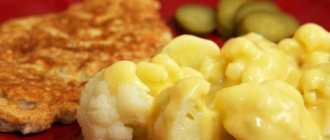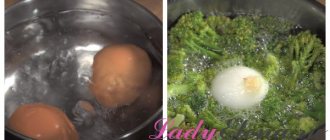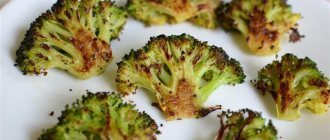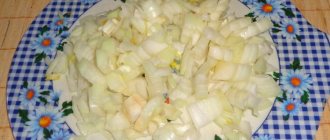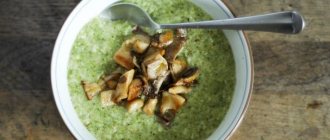Hello everyone friends.
Broccoli cauliflower is deservedly used in dietary and therapeutic nutrition. These vegetables have very delicate fiber, which is completely absorbed by the body.
The benefits of these two types of cabbage are to accelerate metabolic processes in the body, improve the functioning of the heart and blood vessels, cleanse the body of waste and toxins, strengthen the walls of blood vessels, and fight cancer cells. It is recommended to include these vegetables in your diet every day. In our article we offer recipes for broccoli and cauliflower dishes. It will not be difficult to prepare them, and the body will receive a lot of benefits.
General information about species with photos
Genetically, cauliflower and broccoli are related and belong to the same family - Brassicas. Currently, these types of cabbage are grown in large volumes on the American continent, China, and India. Türkiye, Germany, France, and Italy are also considered major cabbage producers.
Cauliflower
The plant is an annual plant, the roots are fibrous, located close to the soil surface. Cabbage has a round stem 15-70 cm high. The leaves are arranged straight or obliquely upward. Sometimes they are curved, cylindrical in shape. Rosettes form in the axils of the upper leaves. The fruits of cauliflower are eaten. The shape of the head is round and flat-round. The color of the inflorescences ranges from cream to snow-white.
Among the variety of cauliflower varieties, there are varieties with a green, yellow and even purple tint.
Broccoli
This species was bred in Italy, but was not popular for a long time. Outside the country, no one knew the vegetable. The name translated from Italian means “flowering cabbage stalk” in the plural. This very stem usually reaches 60-90 cm in height.
At its top, flower stalks with green buds are formed. The buds are neatly collected into a large inflorescence - a loose head. The fruits are cut green, without waiting until they are covered with yellow flowers. Broccoli has a pleasant smell and spicy taste.
You can learn how to grow broccoli in open ground here.
How long to cook broccoli and cauliflower. How and how much to cook broccoli (frozen, fresh)
Broccoli is an unusual, tasty and healthy vegetable, loved by many, which today can be bought almost all year round in a grocery supermarket, fresh or frozen. To cook broccoli deliciously, it will be useful for many to know how long and how to properly cook broccoli (fresh, frozen) in a saucepan and slow cooker.
How long does it take to cook broccoli?
Broccoli cooks fairly quickly and, like cauliflower, has a similar cooking sequence whether fresh or frozen. Let's look at how long you need to cook broccoli until done in different ways:
- How long does it take to cook fresh broccoli in a saucepan? Fresh broccoli should be cooked for 5-7 minutes in a saucepan after the water has boiled.
- How long to cook frozen broccoli? The cooking time for frozen broccoli in a saucepan is 12-15 minutes after the water boils.
- How many minutes to cook broccoli in a slow cooker? The cooking time for broccoli in a slow cooker is 5-10 minutes.
Having found out how long it takes to cook broccoli, we will next consider the cooking process itself in order to know how to properly, quickly and tasty boil broccoli at home.
How to cook broccoli in a saucepan?
One of the most common ways to cook broccoli is to boil it in a saucepan, and the cooking sequence itself is the same for both fresh vegetables and frozen semi-finished products. Let's take a closer look at how to cook broccoli in a saucepan on the stove:
- If the broccoli is fresh, it must first be prepared for cooking. To do this, peel the leaves from the head of cabbage, thoroughly wash the broccoli under running water and cut the inflorescences on the cabbage into small pieces.
- Pour water into the pan so that after adding the broccoli, the water completely covers it and put the pan on high heat and bring to a boil.
- When the water in the pan has boiled, add salt (half a teaspoon per 1 liter of water) and add prepared fresh broccoli (or add frozen ones that do not need to be thawed first).
- When the water boils again, reduce the heat so that the water does not boil too much and cook the broccoli for 5-7 minutes if they are fresh, or 12-15 minutes if they were frozen.
- At the end of cooking, place the cooked broccoli on a plate (do not leave it in boiling water, as it may boil over). Delicious, juicy boiled broccoli is ready to eat.
How to cook broccoli in a slow cooker?
Using a multicooker when cooking broccoli can simplify the cooking process, and it is believed that when cooking in the “Steamer” mode, it allows you to preserve more nutrients and vitamins in this vegetable. Let's take a step-by-step look at how to cook broccoli in a slow cooker:
- Fresh broccoli must be prepared in advance for cooking (peeled, washed and cut), and frozen broccoli can be immediately placed in a special steaming rack in a slow cooker and filled with water so that it partially covers the vegetable.
- Turn on the “Steam Boiler” mode (steam cooking) and set the timer for 5 minutes if the broccoli is fresh, or for 10 minutes if it is frozen.
- After the sound signal, we leave the broccoli for another 5 minutes under the closed lid in the multicooker so that it “reaches”, after which we take it out and put it on a plate.
In conclusion to the article, it can be noted that knowing how to deliciously boil broccoli (frozen and fresh), you can quickly and easily prepare this healthy vegetable for your family. We leave our reviews and useful tips on how to cook broccoli deliciously in the comments to the review and share it on social networks if it was useful to you.
What are the differences: detailed table
Despite the family relationship, these varieties have many differences. Let's consider what is the difference between broccoli and cauliflower?
| Broccoli | Cauliflower |
| Appearance | |
| The color of cabbage is green, sometimes purple. The stem is higher. The inflorescences are larger. | The color of the buds is predominantly white, or with yellowish tint. |
| Growing conditions | |
| The plant is resistant to sudden temperature changes. Grows in any soil, but requires plenty of watering. | The ambient air temperature should be +14-18°C. Prefers soil saturated with magnesium, copper and boron. |
| Maturation period | |
| 1 month passes from planting seedlings into the ground. The yield is greater than that of cauliflower. | From the emergence of seedlings to technical ripeness, 90-120 days pass. |
| Compound | |
| It contains vitamins A, B and C. It has a richer mineral composition. | Contains more vitamin C than orange and other cabbage varieties. |
Broccoli and cauliflower recipes. Dish with spices
Preparation:
- Pour boiling water over 450 pieces of cauliflower, cut into florets. Add salt (1 teaspoon), cover the bowl with a lid and leave for 10 minutes to soften the cabbage.
- Then drain the water, sprinkle the cabbage with chicken seasoning (1 tablespoon) and pour three tablespoons of olive oil.
- Mix and transfer to a baking sheet. Place the baking sheet in an oven preheated to 180 degrees for 20 minutes. Try it - you should like it.
KBJU per 100 g: proteins – 2.42; fats – 6.24; carbohydrates – 5.14; calorie content – 82.52.
Video:
The benefits and harms of cauliflower
- Cauliflower is recommended for therapeutic dietary nutrition for diabetes mellitus, liver diseases, cholelithiasis, and atherosclerosis.
- Due to its rich chemical composition, eating vegetables has a positive effect on the body’s condition.
- Improves the functioning of the digestive system.
- Ensures strong bones and healthy joints, prevents the risk of developing osteoporosis, arthrosis and arthritis.
- Normalizes the functioning of the endocrine system, affects the production of hormones.
- Strengthens the nervous system, improves sleep, prevents depression.
- Promotes the full functioning of the heart, normalizes the water-salt balance in the body.
- Prevents the deposition of sand in the bladder, protecting against urolithiasis.
- Normalizes blood sugar levels, protects the walls of blood vessels from damage.
- Reduces blood cholesterol levels.
- Protects against the development of inflammatory processes in the body and cancer.
- Studies have shown that sulforaphane, contained in cauliflower, destroys cancer cells, slowing the growth of malignant tumors of the breast, uterus, intestines, and prostate.
Despite the enormous value and benefits for the body, eating vegetables can be harmful if:
- gout;
- hyperfunction of the thyroid gland;
- renal failure;
- hypertension;
- after surgical interventions in the abdominal cavity.
Cauliflower can cause allergic reactions or digestive disorders if you are intolerant.
Recipe for Cauliflower and Broccoli Side Dish. Calorie, chemical composition and nutritional value.
Nutritional value and chemical composition of “Cauliflower and Broccoli Side Dish.”
The table shows the nutritional content (calories, proteins, fats, carbohydrates, vitamins and minerals) per 100 grams of edible portion.
| Nutrient | Quantity | Norm** | % of the norm in 100 g | % of the norm in 100 kcal | 100% normal |
| Calorie content | 62.5 kcal | 1684 kcal | 3.7% | 5.9% | 2694 g |
| Squirrels | 2.9 g | 76 g | 3.8% | 6.1% | 2621 g |
| Fats | 3.4 g | 56 g | 6.1% | 9.8% | 1647 g |
| Carbohydrates | 4.5 g | 219 g | 2.1% | 3.4% | 4867 g |
| Organic acids | 0.1 g | ~ | |||
| Alimentary fiber | 2.6 g | 20 g | 13% | 20.8% | 769 g |
| Water | 86.5 g | 2273 g | 3.8% | 6.1% | 2628 g |
| Ash | 0.922 g | ~ | |||
| Vitamins | |||||
| Vitamin A, RE | 42.9 mcg | 900 mcg | 4.8% | 7.7% | 2098 g |
| Retinol | 0.022 mg | ~ | |||
| alpha carotene | 13.889 mcg | ~ | |||
| beta carotene | 0.225 mg | 5 mg | 4.5% | 7.2% | 2222 g |
| beta Cryptoxanthin | 0.556 mcg | ~ | |||
| Lutein + Zeaxanthin | 779.444 mcg | ~ | |||
| Vitamin B1, thiamine | 0.087 mg | 1.5 mg | 5.8% | 9.3% | 1724 g |
| Vitamin B2, riboflavin | 0.116 mg | 1.8 mg | 6.4% | 10.2% | 1552 g |
| Vitamin B4, choline | 36.2 mg | 500 mg | 7.2% | 11.5% | 1381 g |
| Vitamin B5, pantothenic | 0.82 mg | 5 mg | 16.4% | 26.2% | 610 g |
| Vitamin B6, pyridoxine | 0.186 mg | 2 mg | 9.3% | 14.9% | 1075 g |
| Vitamin B9, folates | 47.778 mcg | 400 mcg | 11.9% | 19% | 837 g |
| Vitamin C, ascorbic acid | 65.11 mg | 90 mg | 72.3% | 115.7% | 138 g |
| Vitamin D, calciferol | 0.056 mcg | 10 mcg | 0.6% | 1% | 17857 g |
| Vitamin E, alpha tocopherol, TE | 0.581 mg | 15 mg | 3.9% | 6.2% | 2582 g |
| beta tocopherol | 0.006 mg | ~ | |||
| gamma tocopherol | 0.094 mg | ~ | |||
| Vitamin H, biotin | 0.833 mcg | 50 mcg | 1.7% | 2.7% | 6002 g |
| Vitamin K, phylloquinone | 65.6 mcg | 120 mcg | 54.7% | 87.5% | 183 g |
| Vitamin RR, NE | 0.8635 mg | 20 mg | 4.3% | 6.9% | 2316 g |
| Niacin | 0.283 mg | ~ | |||
| Betaine | 0.056 mg | ~ | |||
| Macronutrients | |||||
| Potassium, K | 289.28 mg | 2500 mg | 11.6% | 18.6% | 864 g |
| Calcium, Ca | 42.38 mg | 1000 mg | 4.2% | 6.7% | 2360 g |
| Silicon, Si | 12.222 mg | 30 mg | 40.7% | 65.1% | 245 g |
| Magnesium, Mg | 21.2 mg | 400 mg | 5.3% | 8.5% | 1887 |
| Sodium, Na | 24.15 mg | 1300 mg | 1.9% | 3% | 5383 g |
| Sera, S | 11.22 mg | 1000 mg | 1.1% | 1.8% | 8913 g |
| Phosphorus, P | 64.9 mg | 800 mg | 8.1% | 13% | 1233 g |
| Chlorine, Cl | 0.52 mg | 2300 mg | 442308 g | ||
| Microelements | |||||
| Aluminium, Al | 316.7 mcg | ~ | |||
| Bor, B | 277.8 mcg | ~ | |||
| Iron, Fe | 1.176 mg | 18 mg | 6.5% | 10.4% | 1531 g |
| Yod, I | 1.67 mcg | 150 mcg | 1.1% | 1.8% | 8982 g |
| Manganese, Mn | 0.204 mg | 2 mg | 10.2% | 16.3% | 980 g |
| Copper, Cu | 50.87 mcg | 1000 mcg | 5.1% | 8.2% | 1966 |
| Molybdenum, Mo | 5.037 mcg | 70 mcg | 7.2% | 11.5% | 1390 g |
| Nickel, Ni | 4.917 mcg | ~ | |||
| Selenium, Se | 1.759 mcg | 55 mcg | 3.2% | 5.1% | 3127 g |
| Fluorine, F | 37.7 mcg | 4000 mcg | 0.9% | 1.4% | 10610 g |
| Chromium, Cr | 0.61 mcg | 50 mcg | 1.2% | 1.9% | 8197 g |
| Zinc, Zn | 0.387 mg | 12 mg | 3.2% | 5.1% | 3101 g |
| Digestible carbohydrates | |||||
| Starch and dextrins | 0.218 g | ~ | |||
| Mono- and disaccharides (sugars) | 3 g | max 100 g | |||
| Glucose (dextrose) | 0.272 g | ~ | |||
| Lactose | 0.117 g | ~ | |||
| Maltose | 0.117 g | ~ | |||
| Sucrose | 0.056 g | ~ | |||
| Fructose | 0.378 g | ~ | |||
| Essential amino acids | |||||
| Arginine* | 0.107 g | ~ | |||
| Valin | 0.071 g | ~ | |||
| Histidine* | 0.034 g | ~ | |||
| Isoleucine | 0.045 g | ~ | |||
| Leucine | 0.074 g | ~ | |||
| Lysine | 0.076 g | ~ | |||
| Methionine | 0.021 g | ~ | |||
| Methionine + Cysteine | 0.001 g | ~ | |||
| Threonine | 0.05 g | ~ | |||
| Tryptophan | 0.019 g | ~ | |||
| Phenylalanine | 0.066 g | ~ | |||
| Phenylalanine+Tyrosine | 0.002 g | ~ | |||
| Nonessential amino acids | |||||
| Alanin | 0.059 g | ~ | |||
| Aspartic acid | 0.182 g | ~ | |||
| Glycine | 0.05 g | ~ | |||
| Glutamic acid | 0.304 g | ~ | |||
| Proline | 0.062 g | ~ | |||
| Serin | 0.068 g | ~ | |||
| Tyrosine | 0.029 g | ~ | |||
| Cysteine | 0.016 g | ~ | |||
| Sterols (sterols) | |||||
| Cholesterol | 7.04 mg | max 300 mg | |||
| beta sitosterol | 1.111 mg | ~ | |||
| Saturated fatty acids | |||||
| Saturated fatty acids | 2.1 g | max 18.7 g | |||
| 4:0 Oil | 0.139 g | ~ | |||
| 6:0 Kapronovaya | 0.031 g | ~ | |||
| 8:0 Caprylic | 0.027 g | ~ | |||
| 10:0 Kaprinovaya | 0.07 g | ~ | |||
| 12:0 Lauric | 0.09 g | ~ | |||
| 14:0 Miristinovaya | 0.291 g | ~ | |||
| 16:0 Palmitinaya | 0.958 g | ~ | |||
| 18:0 Stearic | 0.289 g | ~ | |||
| 20:0 Arakhinovaya | 0.003 g | ~ | |||
| 22:0 Begenovaya | 0.002 g | ~ | |||
| Monounsaturated fatty acids | 1.009 g | min 16.8 g | 6% | 9.6% | |
| 14:1 Myristoleic | 0.031 g | ~ | |||
| 16:1 Palmitoleic | 0.106 g | ~ | |||
| 17:1 Heptadecene | 0.001 g | ~ | |||
| 18:1 Oleic (omega-9) | 0.858 g | ~ | |||
| Polyunsaturated fatty acids | 0.155 g | from 11.2 to 20.6 g | 1.4% | 2.2% | |
| 18:2 Linolevaya | 0.058 g | ~ | |||
| 18:3 Linolenic | 0.038 g | ~ | |||
| Omega-6 fatty acids | 0.1 g | from 4.7 to 16.8 g | 2.1% | 3.4% |
The energy value of the cauliflower and broccoli side dish is 62.5 kcal.
Primary Source: Created in the application by the user. Read more.
** This table shows the average levels of vitamins and minerals for an adult. If you want to know the norms taking into account your gender, age and other factors, then use the “My Healthy Diet” application.
The benefits and harms of broccoli
Broccoli is a source of substances with antioxidant, antitumor, choleretic and anti-inflammatory properties. The content of vitamin C, sulforaphane and indoles provides a powerful anti-cancer effect when consumed regularly.
Research has shown that indoles in broccoli reduce the growth of estrogen-dependent cancers. Women in whose bodies estrogens are quickly destroyed are less susceptible to the occurrence and development of breast and uterine cancer.
Thanks to its beneficial properties, broccoli prevents the occurrence of cancer that develops from chronic inflammatory processes. It helps cure cancer of the bladder, prostate, and colon.
The pharmacological effects of broccoli are not limited to just anti-cancer effects. Due to its rich composition, the vegetable has a positive effect on the entire body:
- normalizes the functioning of the digestive system;
- prevents the development of gastritis and gastric ulcers, enteritis and colitis;
- normalizes blood sugar levels;
- cleanses the body;
- strengthens bones and teeth;
- removes salts from the body;
- strengthens the nervous system;
- reduces cholesterol levels;
- improves vision;
- helps to get rid of excess weight;
- improves the condition of mastopathy.
Based on broccoli extract, medications are produced for the complex treatment of mastopathy: “Indole Forte”, “Mastofit”, “Indinol”.
Despite the beneficial properties of broccoli, its consumption can be harmful to the body. You should limit cabbage for the following diseases and conditions:
increased acidity of gastric juice and associated gastritis, stomach and duodenal ulcers (broccoli stimulates the secretion of hydrochloric acid and can further aggravate the situation);
thrombosis and a tendency to thicken the blood (due to the high content of vitamins K and C, which affect blood viscosity).
Sometimes broccoli causes allergic reactions in the form of skin rashes or severe digestive disorders due to individual intolerance.
Ingredients
To prepare cauliflower stewed with broccoli, you need:
- broccoli – 300 gr.
- cauliflower – 300 gr.
- onion 2 pcs.
- white bread – 100 gr.
- sour cream – 150 gr.
- dill, basil and mint to taste.
The quantity is for 4 servings.
Cauliflower and broccoli can be used either frozen or fresh. When choosing fresh cauliflower, you must take into account that the inflorescences should be white, the stems should be dense and green. You should not choose cabbage with yellow spots on the inflorescences; as a rule, such inflorescences are very bitter. Broccoli should not have yellowed inflorescences and be bright green. With the right approach, the dish will turn out very tender and delicious.
Four options on how to cook quickly, tasty and healthy
There are four main cooking options:
- Cook. To do this, you need to put cauliflower or broccoli, disassembled into inflorescences, into salted water and cook for 7 minutes if the cabbage is fresh, and 10-15 minutes if frozen (about how long to cook broccoli and cauliflower, frozen and fresh, can be found here).
- Fry. Pre-boiled cabbage - cauliflower or broccoli - is fried in a frying pan with oil for 5 minutes. Salt and spices are added to taste (read about how to fry broccoli in a frying pan, as well as other cooking recipes here).
- Put it out. You can simmer the disassembled cabbage inflorescences in a frying pan with a little water and a pinch of salt for about 20 minutes over low heat. After 20 minutes, add sour cream and simmer for another 5 minutes.
- Bake. Sprinkle the disassembled and pre-boiled inflorescences with olive oil and sprinkle with your favorite seasonings and salt and bake for 15-20 minutes (you can learn how to bake broccoli so that it is tender and tasty here).
Video on how to make frozen cabbage pancakes
Pre-defrosting before cooking is not required if only the cauliflower florets were frozen. For a frozen whole head of cabbage:
- Defrost the cabbage in the refrigerator on the top shelf for 4-5 hours.
- At room temperature, wait until the vegetable is completely defrosted.
Dishes in a frying pan
Casseroles - how different they are: sweet, meat, fish, vegetable. And today I bring to your attention a casserole with very tasty vegetables, with the most delicate cream-based sauce.
We will prepare the dish with the addition of chicken fillet. But if you don’t want to add meat, just leave it out, then you’ll get an almost vegetarian casserole.
We will need:
- 500 grams of boiled chicken meat (or to your taste)
- 400 grams of broccoli
- 400 grams cauliflower
- 150 grams of cheese
- 30 milliliters vegetable oil
- 300 milliliters cream
- 1.5 tablespoons flour
- 1 carrot
- 1 onion
- 1 clove of garlic
- salt, ground red pepper and Herbes de Provence seasoning to taste
1. Cut the chicken fillet into small pieces. Cut onions and carrots into small cubes. Grind the cheese on a grater. If you have a hard variety, such as Parmesan, it will be just great. It makes the crust amazingly golden brown and tasty.
2. Heat the frying pan over the fire. Pour in vegetable oil and heat it. Add the onion, simmer for 5 minutes while frying, then add the carrot cubes.
Fry until the onion is slightly browned and the carrots are limp.
3. Next add fillet pieces.
And fry it until the meat turns white, about 10 minutes. During this time, periodically stir the contents so that nothing burns.
4. Add flour. We need it to thicken the sauce, in which case the casserole will not fall apart and will look beautiful when served. Mix well.
5. Once the flour has dispersed and lightly fried, a slight nutty smell will appear. As a rule, this requires 2 - 3 minutes. And that means it’s time to add the cream and, while stirring, bring the resulting sauce to a boil.
There is no need to boil so that the cream does not lose all its beneficial qualities.
6. Rinse cauliflower and broccoli with water and separate into inflorescences. Place them in a heat-resistant dish with high sides. You can choose any method of laying out - either in layers, or interspersed, that is, whichever you like best.
7. Pour the contents of the frying pan over the cabbage, distributing it evenly over the entire surface of the dish. It’s already turning out incredibly beautiful.
8. Immediately sprinkle the dish with cheese. It will not take long to prepare, so cheese in this case will be appropriate right away.
9. Preheat the oven in advance. We will need a temperature of 180 degrees. Place the pan with the contents in the oven and bake for 15 minutes.
During this time, the cheese will brown, and the cabbage will remain slightly crispy, retaining its shape and its wonderful taste.
You can serve the casserole as a separate dish, or with boiled potatoes, rice or pasta. It turns out very tasty!
Get ready for the fact that you will definitely be asked for more.
Sometimes you want to diversify your menu with something unusual and tasty. And if this dish also turns out to be healthy, then you don’t think for a long time, you just take it and cook it.
And here is the recipe - a puree soup made from three types of cabbage - Brussels sprouts, cauliflower and broccoli, and even with spinach. The soup turns out divinely delicious!
This first course takes just ten minutes to prepare.
What you will need:
- broccoli - 0.5 kg.
- Brussels sprouts - 0.5 kg.
- cauliflower - 0.5 kg.
- spinach - 0.3 kg.
- cream - 0.5 l.
- salt, pepper - to taste
1. Immediately prepare all the vegetables, wash them, separate them into inflorescences, if necessary, and peel them, cutting off all excess. You can make soup from fresh or frozen ingredients.
2. Prepare two saucepans. In one of them, the one that is larger, we pour more water accordingly. Here we will cook a mixture of all varieties of cabbage.
Place it on the fire, cover with a lid and bring to a boil. Add salt to taste. As soon as the water boils, throw in all the heads and inflorescences. Bring to a boil again and cook for 7 minutes until tender.
Readiness can be determined this way: pierce the cabbage with a knife; if it is soft, then it is ready.
3. Remove our green variety using a slotted spoon and place it in the bowl of a food processor or mixer. Since we will be making puree, we will need to finely chop all the vegetables.
You can also use an immersion blender. But don't rush yet, we haven't cooked the spinach yet.
4. Heat water in a small saucepan and add spinach to the boil. After boiling, cook it for two minutes. Then drain in a colander, reserving the broth. By the way, I would like to remind you that we also made delicious soups from spinach.
5. Now that everything is cooked, puree the vegetables. If it is difficult to grind, then add a little water in which the spinach was boiled to the blender.
6. Pour the mixture into a saucepan and add as much spinach broth as you need for thickness. Blend everything again with an immersion blender. Bring the mixture to a boil.
Heat the cream and pour it into the pan. Bring to a boil again, but do not boil. Cream does not tolerate boiling.
7. Therefore, as soon as the soup boils, immediately remove it from the stove. Add salt and pepper to taste and close with a lid. Let it sit for another ten minutes.
8. Done! Pour into a plate and garnish with broccoli florets. Great and doesn't take long! Bon appetit!
This soup is good both hot and cold. And needless to say, it simply contains a ton of all sorts of useful substances and vitamins.
As the Chinese proverb says: “Hide the meat under the vegetables.” And this is very correct, healthy and at the same time delicious! And today we decided to use this wisdom. and prepare a delicious, healthy dish.
Cooking broccoli with chicken fillet does not take much time, and at the same time you always get a complete, tasty dish.
We will need:
- Broccoli – 500 grams
- Chicken fillet – 500 grams
- Large carrots - 1 piece
- Onion - 1 piece
- Garlic - 2 cloves
- Salt, pepper - to taste
- Olive oil - 3 tbsp. spoons
1. Wash, peel and cut the carrots into halves if they are large, and into slices if you took two small ones. Try to take it juicy, it will give both color and a sweetish taste.
2. Chop the onion into thin half rings, or you can cut it into quarter rings if the onion is large.
Grind the garlic using any of the known methods. The pieces can be completely invisible. and quite tangible, depending on your preference.
3. Divide the cabbage into florets and cut into separate segments convenient for eating.
4. Cut the fillet into small pieces.
4. Heat a little olive oil in a frying pan and fry the onions and garlic in it. When the onion softens slightly and becomes translucent, add chicken and carrots. Stir immediately and cover with a lid to soften the carrots and turn the chicken white.
Almost all of this needs to be brought to half-ready.
5. Then add broccoli. Immediately add salt and pepper to taste. Cover again and simmer everything together for another 20 minutes, until done.
We determine readiness by taking a sample. Vegetables should not be tough, and the fillet should be well steamed.
In fact, we should not fry this dish, but stew it. To preserve as much as possible the tenderness and original taste of all components. It turns out very tasty, and they always eat it with great pleasure!
In general, it should be said that the combination of broccoli and chicken in any form is always excellent. Even if you just fry the chicken, boil the cabbage and season with garlic.
If we think about what to whip up with minced meat and vegetables, then often thoughts about casserole come to mind. And we have already prepared one of them today in the first recipe.
And now I want to offer one more recipe. This time it will be pasta with vegetables. Oh-oh-oh...how delicious it will be!!!
You probably thought that this would take a long time... No, not long at all, and now, after reading the recipe, you will be pleasantly surprised that preparing such a dish actually couldn’t be easier. And most importantly, the whole process will take place with little time.
We will need:
- Pasta – 160 grams
- Onion - 2 medium heads
- Carrots - 1 piece
- Tomato - 1 piece
- Minced chicken - 200 grams
- Broccoli - 200 grams
- Sour cream - 30 grams
- Parmesan cheese (or other hard cheese) - 30 grams
- Olive oil - 30 grams
- Water - 2 glasses
- Spices to taste
1. Let's immediately prepare everything you need. The cooking process will go quickly, and we will not have time for distraction. And so, cut the onions, carrots and tomatoes into cubes.
Cut the broccoli into convenient-to-eat segments.
Immediately prepare the minced meat and measure the required amount of pasta.
2. Place the pan on the fire and warm it, then pour in the olive oil and let it warm up a little. Conditionally divide the area of the frying pan into segments and immediately lay out all the cuttings, except for the cabbage. Send pasta and minced meat there.
This is how beautiful we got.
3. Pour in the required amount of water and add spices. You can add the ones you like. Provencal herbs, or dried basil with oregano and rosemary are perfect here. The herbs are all light, but have a rich aroma.
Without waiting for it to boil, cover the contents with a lid. Leave to simmer over low heat for fifteen minutes. Don't stir the mixture yet.
4. Add cabbage and sour cream to the steamed ingredients, stir and simmer for another five to seven minutes.
You will need:
- Broccoli – 250 g
- Cauliflower – 250 g
- Garlic - 2 cloves
- Seasonings and spices - to taste
- Olive oil - 2 tbsp.
1. Set the oven to preheat at 180°C, prepare a baking sheet by greasing it with olive oil or covering it with foil.
2. Place broccoli and cauliflower florets into a large bowl and mix with spices, seasonings, olive oil and grated garlic. Mix thoroughly.
3. Place all the cabbage on a baking sheet and bake for about 20 minutes until done. The finished dish can be sprinkled with grated hard cheese and served with creamy sauce.
Broccoli with cauliflower in the oven
Broccoli with cauliflower cooked in the oven is an excellent vegetable dish, especially for those who are watching their calorie intake. But it is worth noting that such a dish not only belongs to the category of healthy food, but also tasty.
The step-by-step preparation of a vegetable dish is as follows:
- Separate 1 head of cauliflower and broccoli into florets and then rinse under cool running water. Place a container of water on the stove, add a little salt and bring to a boil. Then place the prepared inflorescences in boiling water and cook over low heat for 5 minutes.
- Drain the water through a colander and leave the vegetables in it for a few minutes to release excess moisture. After this, place the boiled broccoli and cauliflower in a baking dish. There is no need to pre-treat it with oil.
- Season the vegetables with Provençal herbs and salt to taste. Add 200 ml milk or cream. Grate 350 grams of hard cheese onto the surface.
- Place for baking in the oven, preheated to 180 C for 25-30 minutes. After the vegetables are ready, place them on a dish and serve hot.
- The dish will go perfectly with boiled meat or fish.
Instructions
- Place a large pan of water on the stove, add a spoonful of salt. After boiling, lay out the cauliflower, divided into convenient florets, boil for about 3 minutes, remove with a slotted spoon.
- Place the broccoli in the same water, take it out after half a minute, and immediately place it in a bowl of ice water.
- We get rid of excess liquid.
- After the cauliflower and broccoli have dried, place the vegetables in a frying pan heated with oil.
- Fry until light golden.
- Add coarsely grated mozzarella and finely grated Parmesan. Stir and turn off immediately.
- Place on plates and serve - it tastes better hot, the cheese stretches, the aroma floats through the kitchen... However, it’s also great after it cools down.
- Bon appetit!
Broccoli and cauliflower casserole: a simple recipe
Broccoli and cauliflower casserole is prepared very quickly and turns out very tasty.
Preparation is as follows:
- Take 200 grams of broccoli and cauliflower, separate into inflorescences. Place in a container with deep sides. Add half a teaspoon each of paprika and a mixture of peppers, a pinch of ground dry garlic and salt.
- Pour in 2 tablespoons of olive oil and mix thoroughly to evenly distribute the added ingredients throughout all the inflorescences.
- Place in a ceramic baking dish, cover with food foil and place in the oven, heated to 200 C for 10 minutes.
- Remove the foil and place in the oven for another 5 minutes until golden brown.
- After this, you can serve the fragrant and rosy casserole to the table.
What can you cook from broccoli?
Broccoli is a type of cabbage. One of the healthiest vegetables in the world. But despite its popularity, few people know how to cook broccoli in a tasty and healthy way.
What are the benefits of broccoli? It is a real storehouse of substances beneficial for the body. It is a good source of fiber, vitamins B, C, K, PP, E, as well as the minerals iron, phosphorus, manganese, calcium, sulfur and zinc.
To preserve all the vitamins, you need to cook broccoli properly. An important advantage of broccoli is its excellent compatibility with any cereals, vegetables, and meat. This makes it possible to make the menu varied.
- How to cook fresh broccoli
- How to make broccoli salad
- – Broccoli salad with apples
- – Broccoli salad with oranges
- How to cook broccoli and cauliflower
- Stewed broccoli
- How to cook broccoli in a frying pan
- – Broccoli in breadcrumbs with cheese
- – Broccoli in a frying pan in batter
- Cooking broccoli in a slow cooker
- – Broccoli fried in a slow cooker
- – Steamed broccoli in a slow cooker
- – Broccoli in a slow cooker in sauce
- How to cook broccoli video
- Broccoli, Potato and Brisket Casserole
.
How to cook fresh broccoli
Broccoli is an excellent vegetable for fighting cellulite. The best part is that you don't even need to cook the broccoli for this!!! Just wash the cabbage. Divide the broccoli into florets, place in a salad bowl and serve. The composition can be supplemented with fresh carrots, apples, and seeds. .
How to make broccoli salad
Broccoli salads are simply amazing. The taste of broccoli is so versatile that it can be complemented with vegetables and fruits.
Roasted Cauliflower
This dish is suitable both as a main dish and as a vegetable side dish for meat or fish.
It's easy and quick to prepare, and you get a crispy crust that won't harm your figure at all.
Ingredients:
- 1 cauliflower.
- 2 tablespoons olive oil.
- Seasonings to taste.
Preparation:
- We separate the cabbage into inflorescences and pour boiling water over it, add a little salt. Cover with a lid and let sit for 10 minutes. This is enough for the cabbage to become soft.
- Drain the water and sprinkle the vegetables with seasoning. It can be ready-made, for example, chicken seasoning, or any other of your favorites. Goes well with turmeric. If the seasoning does not contain salt, add additional salt to taste.
- Add olive oil there and mix gently so that the seasoning and oil cover all the inflorescences.
- We transfer them to a baking sheet with a non-stick coating and place them in an oven preheated to 140 degrees for 15-20 minutes.
- This time is often enough for the inflorescences to become a pleasant golden color.
- You can add breadcrumbs to the cabbage, then the dish will be even crispier, but also a little more caloric.
Broccoli and cauliflower recipes. Cream soup
Preparation:
- Separate 650 g of broccoli into florets, cut 4 potatoes into pieces and throw into boiling water (1.5 l). Chop one onion and grate 4 carrots on a coarse grater.
- Fry the onion in a frying pan until golden brown, then add the carrots to it and continue to fry until the carrots become soft. Pour the roast into the boiling soup and turn off the fire.
- Salt the soup (1 teaspoon) and grind the contents of the pan with a blender. Diet puree soup is ready.
KBJU per 100 g: proteins – 1.11; fats – 0.15; carbohydrates – 4.32; calorie content – 21.02.
Video:
How are dietary meals prepared?
The main advantages of both types of cabbage described are their excellent taste and dietary qualities.
The inflorescences are eaten. Since their sizes are quite large, the individual heads are cut into pieces. Most often the prepared pieces are boiled. Adding a pinch of granulated sugar to boiling water helps to maintain its attractive appearance during cooking.
Cabbage acquires its unique piquant taste when briefly cooked not in ordinary water, but in mineral water. True connoisseurs of the delicacy prefer to serve boiled inflorescences with a sauce of butter and eggs.
The valuable product is prepared not only by cooking. You can do a lot of interesting and tasty things with it:
- Stew with vegetables, including tomatoes, onions, carrots, potatoes.
- Fry with meat or minced meat.
- After boiling, fry in batter: sour cream, beer, rolled in breadcrumbs.
- Make nutritious vegetable broths and soups.
- Close canned food for the winter, either separately or with other vegetables.
- Freeze for long-term storage.
- Season with a variety of sauces.
- Use in casseroles.
- Add to salads.
It is recommended to keep cooking to a minimum. Overcooked vegetables not only lose their visual appeal, but also become excessively soft. For broccoli, simply blanching is sufficient. Cabbage turns out delicious when cooked in a double boiler or slow cooker.
Cooking tips
- Cauliflower and broccoli have an irregular shape, the inflorescences often peek out of the pan and casseroles, and burn. To prevent this from happening, you can grease them with sour cream or mayonnaise.
- If you have cooked more inflorescences than you need, you can freeze them. It is advisable to dry it a little on a napkin first. But you cannot put vegetables that were taken from there before cooking into the freezer. Repeated freezing will destroy all vitamins.
- Not much salt is added during cooking, so you should definitely taste the cabbage and add more spices before frying or putting it in the oven.
- Cauliflower masquerades perfectly as potatoes. For this reason, it is often added or used in dietary purees and other side dishes and soups.
- Broccoli may not have a very attractive color, this must be taken into account when mixing with other vegetables when preparing puree. The best way to disguise the shade is to sprinkle the dish with herbs, crackers, seeds, and pour sour cream or cream.
Chinese beef with cabbage
This is an original dish that can be served for lunch and dinner. And most importantly, it turns out healthy, since its main ingredients are broccoli and cauliflower.
The recipe for the dish is as follows:
- First, you need to dilute starch (2 tablespoons) in a glass of cold water. Then add sugar and sesame oil (1 teaspoon each), salt (half a teaspoon), soy sauce (2 tablespoons), a pinch of Chinese five spices and ground black pepper.
- Cut the beef into small strips. Add soy sauce (30 ml) to the meat and marinate it for 15 minutes.
- At this time, prepare broccoli (1 head) and cauliflower (400 g), boil the vegetables for two minutes and cool.
- Fry the beef in vegetable oil (2 tablespoons), browning on each side, then transfer to a plate.
- Pour a little more oil into the pan, add a teaspoon of grated ginger and the same amount of garlic, and heat for 30 seconds.
- Then add the cabbage, and after a minute pour in the sauce.
- As soon as it starts to thicken, transfer the beef to the pan. Keep the dish on the fire for another minute and you can taste it.
Dietary casserole of cauliflower, broccoli and green beans
Preparation:
- Boil 100 g of green beans in 2 liters of water, then catch the beans and put them on a baking sheet, and in the same water boil 450 g of cauliflower disassembled into inflorescences for 2 minutes, then put it on the beans and do the same with the broccoli. Finely chop two cloves of garlic and add to the vegetables.
- Whisk two eggs in a bowl, not forgetting to add salt (0.5 teaspoon). Add 3 tablespoons of mayonnaise and 2 tablespoons of sour cream to the eggs - mix everything well and pour the contents over the vegetables.
- Place the baking sheet in the oven, preheated to 180 degrees, for a quarter of an hour, then remove the baking sheet, sprinkle the vegetables with finely grated cheese (100 g) and put the baking sheet back in the oven for 10 minutes. The delicious casserole is ready.
KBJU per 100 g: proteins – 5.14; fats – 6.73; carbohydrates – 4.4; calorie content – 94.77.
Video:
Broccoli and cauliflower on the side
A delicious side dish for meat can be prepared not only from rice or potatoes, but also from other vegetables. For example, broccoli and cauliflower are great for this.
Recipes for preparing side dishes are as follows:
- Broccoli (400 g) is lightly fried in a frying pan with vegetable oil, then 125 ml of water is added, after which the cabbage is stewed under the lid for 10 minutes.
- Similar steps are repeated with cauliflower. Place two types of cabbage in one bowl. In another frying pan, fry the onion, add salt, pepper, mustard seeds (1 teaspoon), garlic (4 pieces) and grated ginger (1 tablespoon).
- Everything is fried together for no more than a minute, after which the cabbage is laid out in the frying pan and heated under the lid for no more than two minutes.
- The dish is sprinkled with cilantro.
An equally tasty side dish can be prepared in the oven. First, broccoli and cauliflower need to be cooked until half cooked, then put in a mold and poured with a mixture of egg, cream (100 ml) and grated cheese (100 g). Place the dish in the oven for 10 minutes.
Broccoli and cauliflower recipes. Unusual salad
Original broccoli salad recipe.
- Separate 250 g of broccoli into florets and cut into pieces. Set the bowl of broccoli aside and prepare the dressing. Place one clove of garlic in a mortar, sprinkle with half a teaspoon of salt and grind. Pour one tablespoon of honey into a bowl, add the crushed garlic there, add apple cider vinegar (1 tablespoon) and linseed oil (1 tablespoon) - mix everything well.
- Pour the dressing into the bowl with the broccoli and stir the contents. Cover the broccoli with a plate and leave to marinate for half an hour. Then add 1 teaspoon of cranberries (you can cut the same amount of raisins in the absence of cranberries) and one teaspoon of any chopped nuts. For piquancy, you can cut a quarter of an apple into thin slices. Mix everything again and try.
KBJU per 100 g: proteins – 2.44; fats – 6.77; carbohydrates – 11.78; calorie content – 111.42.
Video:
How to cook broccoli and cauliflower in a slow cooker
A very quickly delicious side dish for dinner can be prepared in a slow cooker. Even frozen vegetables are suitable for this: broccoli, cauliflower, beans.
The cooking recipes are as follows:
- Select the multicooker mode “Baking” or “Frying”.
- Pour some oil into the bowl, heat it and add frozen vegetables (200 g of each type). Fry the cabbage on both sides for 5 minutes.
- After this, add 20% fat sour cream (70 ml), salt and pepper, close the multicooker lid and fry them for another 10 minutes.
- Using the same mode, fry 300 g of each type of cabbage and half as much green beans in oil. Add diced carrots and bell peppers. Fry the vegetables for 15 minutes, then switch the multicooker to the “Stew” mode, pour half a glass of water, add salt and pepper, and cook the dish for another 10 minutes. Garnish with grated cheese and herbs.
Broccoli and cauliflower recipes. Vegetable soup with green peas
Preparation:
- Cut three potatoes, one carrot and one parsley root into cubes. Pour everything into 3 liters of prepared chicken broth and cook for 15 minutes.
- Cut two stalks of green onions (the white part) into rings and fry in 50 grams of butter. Separate 300 g of cauliflower into florets, then chop the green onions and put everything in the boiling soup. Add 100 g of green peas or canned corn and stewed onions. Salt (1 teaspoon), pepper (0.5 teaspoon ground black pepper), cover with a lid and cook for another 10 minutes.
- At the end of cooking, add chopped herbs (parsley and dill - 80 g each), cover with a lid, remove the pan from the heat and let it brew for 15 minutes.
KBJU per 100 g: proteins – 2.1; fats – 1.44; carbohydrates – 2.75; calorie content – 32.72.
Video:
